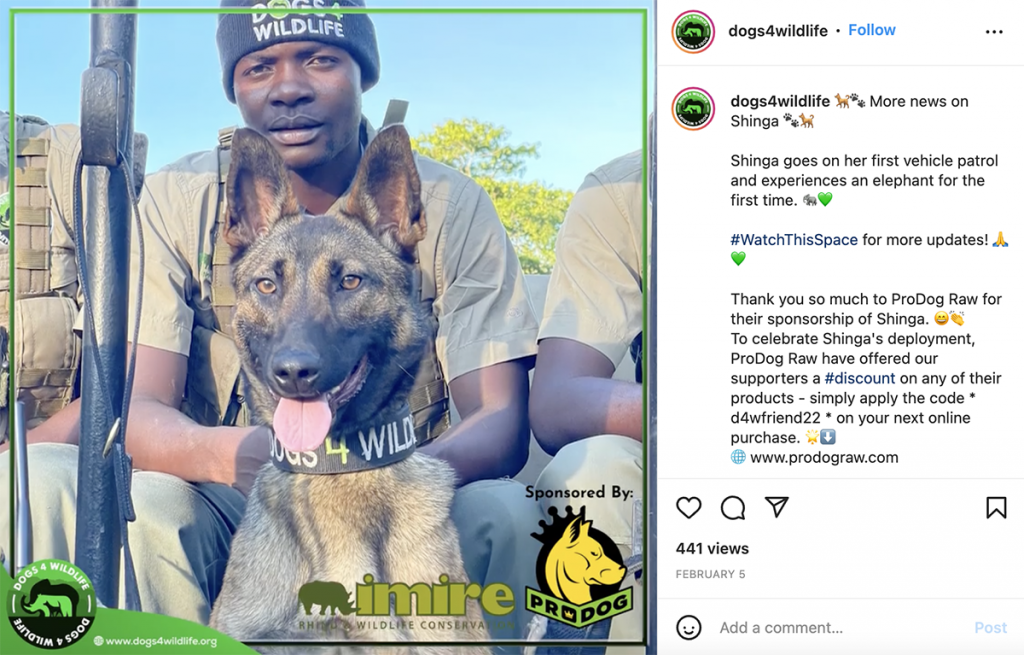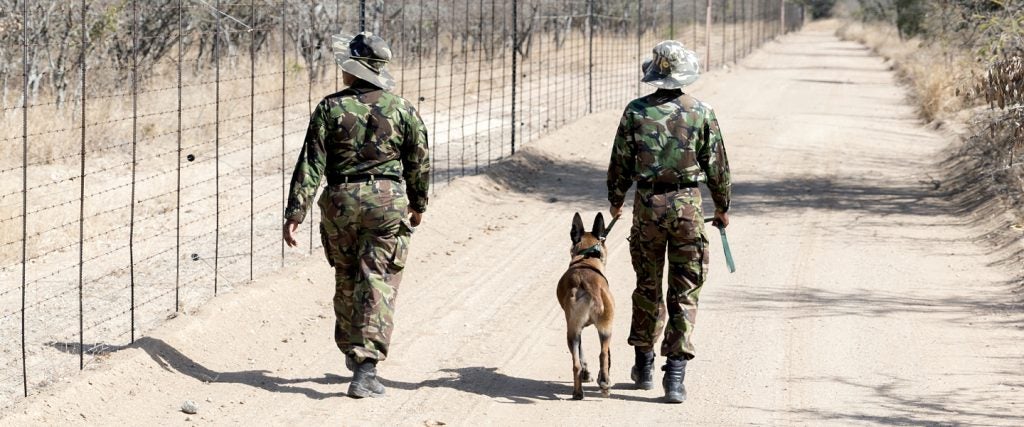When one of the anti-poaching dogs at the Mankwe Wildlife Reserve in the North West province of South Africa detects a poacher or a carcass, things, as Richie Fourie, the assistant reserve manager, says, “kick into overdrive.” The dogs and their handlers are usually walking by the reserve’s fence line, and are looking out for car tracks or blood — any sign that rhino poachers are trespassing. If they find something, the management team is deployed, and all known entry and exit points are blocked off. “Then we go on foot to track the poachers,” Fourie tells me. “It can be quite intense if they’re found.”
If an apprehended poacher tries to run, the anti-poaching dogs follow — a tactic that Fourie says always stops them in their tracks. At the time of publication, Mankwe’s dogs have caught around 73 poachers.
Between 2008 and 2021, approximately 11,000 rhinos were killed by poachers across southern Africa, in Namibia, Botswana, Zimbabwe and South Africa. In 2020, poachers in the latter country — home to the majority of the world’s rhinos — slaughtered 24 in just two weeks. Detection and tracking dogs, like those at Mankwe, are an effective way to deter and catch poachers — hopefully before they manage to kill.
“Their adaptability, intelligence, ability and desire to work alongside human beings [makes dogs an invaluable asset to anti-poaching teams],” says Darren Priddle, the director of Dogs 4 Wildlife, a U.K.-based company that trains anti-poaching dogs and provides them to conservancies and national parks across southern Africa. These dogs are usually supplied to reserves that have had rhino or bushmeat poaching in the past, with the aim of eradicating it in the future. “[The dogs] will always be trained, and will always go out operationally on deployment, but if they never have to actually track and apprehend a poacher, that, for me, is good news,” he adds.
Poachers are after rhinos for their horns, which are lucrative when sold on the black market in China and Vietnam (it’s been illegal to trade rhino horn internationally since 1977). Many people believe that, when ground into a powder, rhino horn can cure a variety of ailments, including hangovers and food poisoning, as well as hallucinations and “devil possession.” Over the years, a rumor has spread that rhino horn can also be used as an aphrodisiac. There’s even a U.S. brand called Rhino that sells pills (not containing rhino horn) to help with erectile dysfunction — using the rhino’s size and force as a sexual marketing tactic — though the FDA has warned people against buying them. None of the claims about rhino horn are true — it has no medicinal benefits to humans — and yet, rhino horn can fetch up to $60,000 per kilo. The horns are also sought after as a status symbol and demonstration of wealth.
Bushmeat poaching, on the other hand, is the illegal hunting of wildlife for meat — either for consumption or sale. According to Global Conservation Force, the bushmeat crisis has been exacerbated during the pandemic, as lockdowns and economic disruption have increased poverty and food insecurity. This kind of poaching frequently results in the collateral death of animals that aren’t the primary target, like lions.
This is where the dogs come in. Dogs 4 Wildlife breeds its own dogs, to, as Priddle says, “produce the right type of dog.” The breeds include Belgian Malinois, Dutch Shepherds, English Springer Spaniels and more. The team then goes through a “rigorous testing program” to select the right puppy to ensure its temperament and character, and make sure its attributes “are exactly what’s needed for suitability for operational deployment.”
In January, Priddle deployed a Belgian Malinois called Shinga to Imire, a rhino and wildlife conservancy in Zimbabwe — her journey to the reserve is documented in the short film above. The attributes that make her a good anti-poaching dog are her sociability and affability. “She has a lot of good qualities in terms of her ‘working drive,’” Priddle explains. “She likes working with a human trainer — she’s a very happy, intelligent dog.” This made her a particularly good fit for Imirie, he adds, which is a “wonderful, social environment.” “There’s a lot of community involved, and lots of people coming and going. That type of reserve needed a dog that was much more social than a typical frontline poaching dog.”

Each Dogs 4 Wildlife dog goes through around 12 to 15 months of training before being sent to its eventual home. At this point, says Priddle, the dogs will be “highly trained” and will have “a good understanding of tracking, obedience control and biting, as well as detection.” Over the next six months after the dogs arrive on their reserve, Dogs 4 Wildlife works with the rangers there to give them an advanced handler training program. Priddle says this helps them get the dog to “a fully operational standpoint where they can utilize [it] to help protect their wildlife.” It takes months for the dogs to acclimatize to the reserve and its rangers, and get used to all the scents and odor of the bush. Shinga is currently still in her secondary training phase in Zimbabwe, but once she becomes operational, she’ll patrol Imire’s boundaries, checking for signs of poacher incursions. She’s the second Dogs 4 Wildlife canine to be deployed to Imire, joining Murwi, who arrived in 2018.
Dogs 4 Wildlife offers two types of dogs. The first is a dual-purpose dog, which specializes in tracking and apprehension — like Shinga. “That dog is predominantly tasked with long-distance tracking of human scent, as well as defending its handlers if the need arises,” says Priddle, asserting that this is “only ever used as a last resort.” The second type of dog is a bushmeat detection dog, whose job is to “search an area of bush to indicate if there’s been a recent kill, then locate the carcass.” Detection dogs can also be used to check vehicles, bags or people to find “illicit wildlife contraband” like rhino horn.
Priddle has just returned from deploying another detection dog named Indy to Mankwe, where, I discovered just before our phone call, he spent eight days with my sister, Melissa, who works as the research coordinator there. Mankwe has had an anti-poaching unit since 2014, but only introduced dogs to it in 2016, after the reserve was hit by rhino poachers. “It was established when we couldn’t cope with just guys on their own,” she tells me, adding that the anti-poaching unit doesn’t carry weapons when it goes out on patrol. Indy is Mankwe’s first Dogs 4 Wildlife dog, as the other two — both German Shepherds — are rescues and former police canines in the early stages of their training.
“They were badly beaten and had multiple broken ribs,” Melissa recalls. “They had abuse thrown at them during their training scheme — it was very much a heavy negative reinforcement training. So we had to do a lot of behavioral corrections.” Although these dogs are highly trained and specialized for anti-poaching purposes, that doesn’t mean they aren’t just like any other dog. “The love and care they have is amazing,” Melissa continues. “The bond they share with their handlers is immense.”

Since she arrived three months ago, Priddle says that Shinga has settled in quickly, and has immediately become close with the rangers at Imire. “Within three days of Shinga being there, it was like she’d always been there,” he says. “It was like it was meant to be — I’ve never seen anything like it in my life.” Indy is also settling in well at Mankwe, and had her first training session two weeks ago.
Priddle hopes that by sharing the journeys of Dogs 4 Wildlife’s dogs — who you can donate to here — people will pay attention to the ongoing poaching crisis, which he says “isn’t in vogue to be pushed by the media anymore, so, even though private landowners are losing rhino left, right and center, nobody knows about it other than the police and the people who are having to see it with their own eyes.”
“[Poaching] isn’t going away anytime soon,” he adds. “People bury their heads in the sand because it’s not pushed in their faces. But it’s happening, and it’s happening all of the time.”
While the world turns away, the newly deployed dogs are getting down to business, joining each reserve’s veteran anti-poachers. “Dogs are a massive fear to the poaching community, and provide a deterrent to not come in,” says Melissa. “They’re an invaluable tool, and we couldn’t function without them.”

